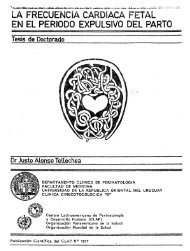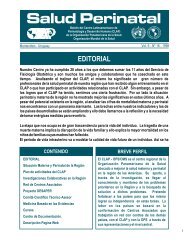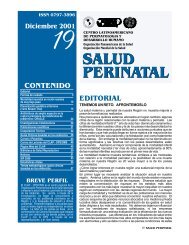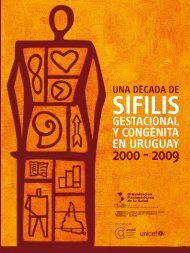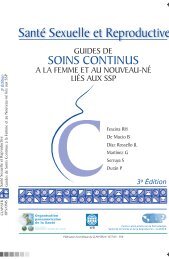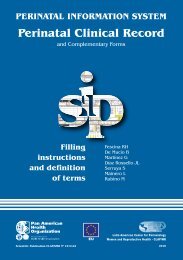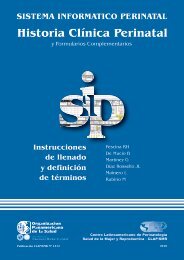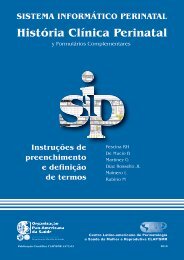Create successful ePaper yourself
Turn your PDF publications into a flip-book with our unique Google optimized e-Paper software.
19. Gove S. Integrated Management of Childhood Illness by outpatient health workers: technical basis andoverview. The WHO Working Group on Guidelines for Integrated Management of the Sick Child. BullWorld Health Organ. 1997;75 Suppl 1:7-24.20. Gupta R, Sachdev HP, Shah D. Evaluation of the WHO/UNICEF algorithm for Integrated Management ofChildhood Illness between the ages of one week to two months. Indian Pediatr. 2000 Apr;37(4):383-90.21. Heiby JR. Quality improvement and the Integrated Management of Childhood Illness: lessons fromdeveloped countries. Jt Comm J Qual Improv. 1998 May;24(5):264-79.<strong>22</strong>. Integrated Management of Childhood Illnes (IMCI). A joint WHO/UNICEF initiative. Ginebra,Organización Mundial de la Salud/Fondo de las Naciones Unidas para la Infancia, 199723. Integrated Management of Childhood Illness: a WHO/UNICEF initiative. Bulletin of the World HealthOrganization, 1997, 75 (supl. No 1).24. Integrated Management of Childhood Illness: documentation of experience in seven countries, July 1995to December 1996. Ginebra, Organización Mundial de la Salud, 199725. Kalter HD, Salgado R, Moulton LH, Nieto P, Contreras A, Egas ML, Black RE. Factors constrainingadherence to referral advice for severely ill children managed by the Integrated Management of ChildhoodIllness approach in Imbabura Province, Ecuador. Acta Paediatr. 2003;92(1):103-10.26. Lambrechts T, Bryce J, Orinda V. Integrated Management of Childhood Illness: a summary of firstexperiences. Bull World Health Organ. 1999;77(7):582-94.27. Nicoll A. Integrated Management of Childhood Illness in resource-poor countries: an initiative from theWorld Health Organization. Trans R Soc Trop Med Hyg. 2000 Jan-Feb;94(1):9-11.28. No authors listed. Integrated Management of Childhood Illness. Rev Panam Salud Publica. 1997Aug;2(2):138-41.29. No authors listed. Integrated Management of Childhood Illness (IMCI) Healthy Children: Goal 2002.Epidemiol Bull. 1999 Dec;20(4):3-6.30. No authors listed. Integrated Management of Childhood Illness (IMCI) in the Americas. EpidemiolBull. 1998 Mar;19(1):1-8.31. No authors listed. Integrated Management of Childhood Illness: conclusions. WHO Division of ChildHealth and Development. Bull World Health Organ. 1997;75 Suppl 1:119-28.32. No authors listed. Research to support household and community IMCI. Report of a meeting, <strong>22</strong>-24January 2001, Baltimore, Maryland, USA. J Health Popul Nutr. 2001 Jun;19(2):S111-48.33. Patwari AK, Raina N. Integrated Management of Childhood Illness (IMCI): a robust strategy. Indian JPediatr. 2002 Jan;69(1):41-8.34. Pelto GH. Integrated Management of Childhood Illness: challenges from the community. Kangaroo.1994 Jul;3(1):64-6.35. Robinson D.The Integrated Management of Childhood Illness. Afr Health. 1996 Sep;18(6):20-1.36. Rowe AK, Hirnschall G, Lambrechts T, Bryce J. Linking the Integrated Management of Childhood Illness(IMCI) and health information system (HIS) classifications: issues and options. Bull World HealthOrgan. 1999;77(12):988-95.37. Shah D, Sachdev HP. Evaluation of the WHO/UNICEF algorithm for Integrated Management ofChildhood Illness between the age of two months to five years. Indian Pediatr. 1999 Aug;36(8):767-77.38. Wammanda RD, Ejembi CL, Iorliam T. Drug treatment costs: projected impact of using the IntegratedManagement of Childhood Illnesses. Trop Doct. 2003 Apr;33(2):86-8.39. Winch PJ, Leban K, Casazza L, Walker L, Pearcy K. An implementation framework for household andcommunity Integrated Management of Childhood Illness. Health Policy Plan. 2002 Dec;17(4):345-53. 33MANUAL CLÍNICO AIEPI NEONATAL



